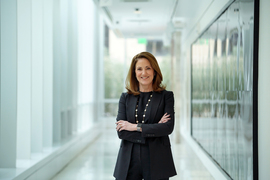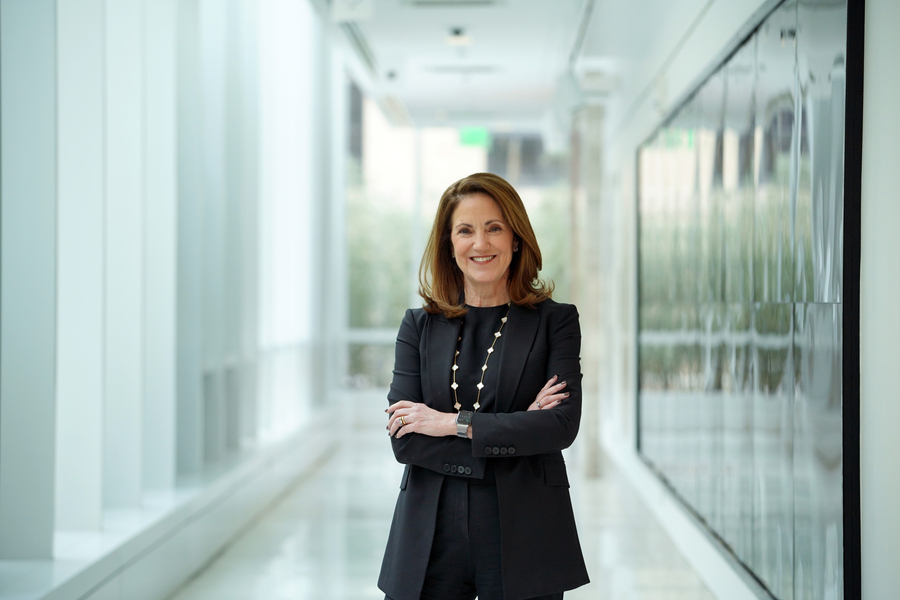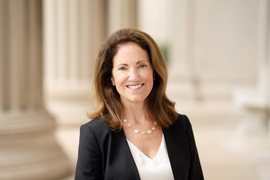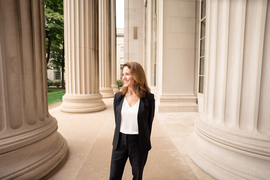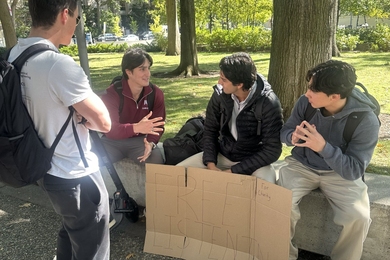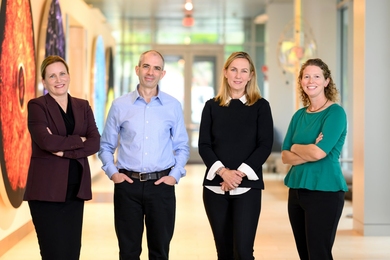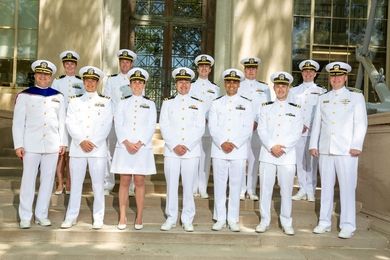Cynthia Barnhart SM ’86, PhD ’88 will step down as MIT’s provost, effective July 1, President Sally Kornbluth announced today. Barnhart, who served as MIT’s chancellor for more than seven years before becoming provost in 2022, will return to the faculty following a sabbatical.
Barnhart led a variety of efforts to enhance academics and research at the Institute during her tenure as provost, which bridged a transition between two MIT presidents. She drew from deep-rooted experience in the MIT community, first as a graduate student and then as a faculty member for more than 30 years, serving in the Department of Civil and Environmental Engineering and in the MIT Sloan School of Management, with affiliations in the Operations Research Center and the Center for Transportation and Logistics.
Barnhart is only the second MIT administrator, following Julius Stratton, to serve as both chancellor and provost. She is also the first woman to serve in each of these roles.
“It has been a privilege to serve and to support our community’s efforts to lead in education, research, and impact in the world,” Barnhart says.
MIT’s provost is the Institute’s chief academic and budget officer, responsible for leading efforts to establish academic priorities, managing financial planning and research support, and overseeing MIT’s international engagements. The provost works closely with the president, school and college deans, vice provosts, executive vice president and treasurer (EVPT), faculty officers, and many other leaders to recruit and retain the best talent and then, as Barnhart puts it, “create the conditions for them to thrive and do their best work at MIT.”
“Cindy has been a wonderful partner in thinking and doing, and I will be forever grateful for having been able to tap her knowledge of the Institute’s people, culture, practices and institutional systems,” Kornbluth wrote in an email to the MIT community.
The next chapter
L. Rafael Reif named Barnhart provost as he was stepping down as MIT’s 17th president, citing her “values, skills, vision, and collaborative spirit.” Her appointment provided the Institute with continuity and helped to sustain momentum during the transition and the first years of Kornbluth’s presidency.
“A good provost is constantly solving problems over the widest range of scales, thinking at the level of systems and structures but also digging deep when needed. Cindy has brought discipline, commitment, and heart to this role, and it's been a privilege to work with her,” says Faculty Chair Mary Fuller.
As she proceeds with a long-planned sabbatical, Barnhart will focus on a project she has been working on as provost. The effort centers around creating a flexible, affordable educational experience and curriculum in order to dramatically increase the size of the nation’s science- and technology-based workforce.
Creating conditions for faculty to thrive
As chief budget officer, Barnhart worked closely with EVPT Glen Shor, Vice President for Finance Katie Hammer, and colleagues across the Institute to provide essential resources for the Institute’s education and research enterprises. She cites as points of pride implementing new central support for MIT’s under-recovery system, closing the NASA and U.S. National Science Foundation (NSF) fellowship tuition and stipend shortfalls, and expanding the number of Office of the Provost professorship chairs to 230, an increase of more than 20 percent.
“The review of the Institute’s budget process that we launched last year is critical to the Institute’s effective response to emerging financial constraints,” Barnhart says.
“It’s about providing our community with access to the tools needed to develop strategic, creative ways to deploy our resources so that, even in the face of budget challenges, we can help people do what they came here to do — discover, invent, innovate, and problem solve, all in service to the nation and the world,” she says.
Responding to calls for more faculty involvement in searches to identify faculty leaders in the Office of the Provost, Barnhart established best practices for search advisory committees. Over the course of her tenure, these faculty-led groups assisted with the appointments of Vice Provost for Faculty Paula Hammond, Vice Provost for Open Learning Dimitris Bertsimas, Vice Provost for International Activities Duane Boning, MIT Sloan School of Management Dean Rick Locke, and Interim CEO and Director of the Singapore-MIT Alliance for Research and Technology (SMART) Bruce Tidor. In addition, Barnhart convened a search committee to identify a new leader to steward MIT’s research enterprise, which informed President Kornbluth’s appointment of Vice President for Research Ian A. Waitz last year.
“MIT’s next provost is going to be working with an exceptional team,” says Barnhart. “The Provost’s Office is positioned to ensure the faculty have what they need to make big impacts in research and education.”
Barnhart took several steps to provide her leadership team and faculty more broadly with professional development and career advancement opportunities. She standardized appointment and reappointment terms, created 360-degree feedback mechanisms, and formalized reappointment review processes for deans and vice provosts. In partnership with Hammond, new programs were launched on establishing positive department climates, generating impactful research funding proposals, and fostering effective graduate student mentoring.
“Cindy has always cared greatly about the faculty experience, and this deep regard is evident in all that she has done,” Hammond says. “She has sought to understand how we might better build a supportive environment that fosters faculty success and has invested in meaningful programs and policies that help to address faculty needs while developing tools for faculty to accomplish their professional and leadership goals.”
Barnhart and Hammond also partnered with Fuller, the MIT Institutional Research team, and other colleagues to assess MIT’s progress on addressing the findings of two landmark reports: the 1999 Study on the Status of Women Faculty in Science at MIT and the 2010 Report on the Initiative for Faculty Race and Diversity.
Barnhart shared the group’s analysis and corresponding response plan with the entire faculty. In her message, Barnhart highlighted how “the original reports’ power sprang from the rigorous analysis the authors conducted and from how openly our community reflected on the problems they identified. For MIT to foster the diverse breadth of faculty excellence that is critical to our mission, we need that same collective embrace of data and transparency, dialogue and action again.”
Advancing 21st-century education and research
Barnhart is committed to making MIT’s education accessible and affordable to a much broader set of learners. With Bertsimas, Barnhart launched the next phase of MIT Open Learning, which involves ambitious plans to extend MIT’s commitment to providing global access to the Institute’s brand of education.
“With her good judgement, open mindedness, passion for quality education in the world, and love and deep knowledge of MIT, Cindy has been a great partner in reshaping the strategy for open learning,” Bertsimas says. “I look forward to continuing our partnership in the years to come.”
As computing has become increasingly integral to many disciplines, the creation of interdisciplinary computing courses through The Common Ground, degrees that blend computing with another field, and interdisciplinary computing faculty hires have expanded the forefront of MIT education and research. With Barnhart as a strong champion, the MIT Schwarzman College of Computing has been at the center of these efforts.
“Embracing the college’s efforts to broaden and deepen MIT’s world-leading strengths in interdisciplinary education and research is, simply put, in Barnhart’s DNA,” says Dan Huttenlocher, dean of the MIT Schwarzman College of Computing.
By design, the Institute’s strategic initiatives in climate, humanities, and life sciences also lean into this interdisciplinary approach. Barnhart worked alongside Kornbluth, Chief Innovation and Strategy Officer Anantha Chandrakasan, and many other faculty on the development of these efforts throughout her tenure.
“It has been a privilege working with Provost Barnhart and President Kornbluth to advance the Institute’s wide range of strategic initiatives,” says Chandrakasan. “With a sense of urgency that these initiatives demand, Provost Barnhart was instrumental in defining the vision for these missions, promoting broad engagement from the MIT community and beyond while paving critical pathways for seed funding and fundraising. It would have been impossible to launch these initiatives without her inspiring ideas, creative solutions, and incredible support.”
A systems thinker
After earning her PhD in transportation systems in 1988 at MIT, Barnhart joined the operations research faculty at the School of Industrial and Systems Engineering at Georgia Tech. She returned to MIT four years later in 1992 and has been at the Institute ever since. Her research, which she has continued throughout her time in leadership roles, focuses on the development of optimization models and methods for designing, planning, and operating transportation systems.
“I’m a systems thinker, an optimizer, and a problem solver,” Barnhart says. “That is one of the reasons I have enjoyed serving as provost, a role in which there certainly is no shortage of opportunity to apply my decision-making and problem-solving mindset.”
Barnhart became associate dean of the MIT School of Engineering in 2007 and served as acting dean in 2010-2011. As chancellor, she was responsible for “all things students” at MIT, including student life, undergraduate admissions, graduate student support, the first-year educational experience, and more. She also participated in strategic planning, faculty appointments, resource development, and campus planning as chancellor.
Barnhart has been an undergraduate adviser and has supervised graduate and undergraduate theses of students across the Institute, including in the departments of Civil and Environmental Engineering, Aeronautics and Astronautics, Mechanical Engineering, and Electrical Engineering and Computer Science; in the Engineering Systems Division; in the MIT Sloan School of Management; in the Operations Research Center; and in the Center for Transportation and Logistics. She has taught subjects jointly listed in these units on optimization and operations research, with applications to transportation operations, planning, and control.
Kornbluth will work with a group of faculty members drawn from each school and the college to help her in selecting the next provost.
